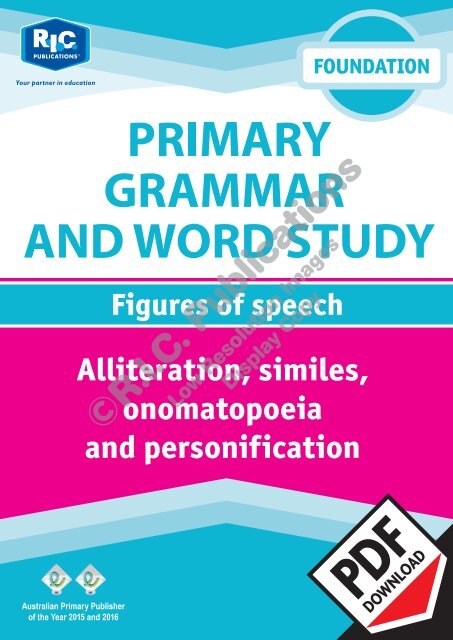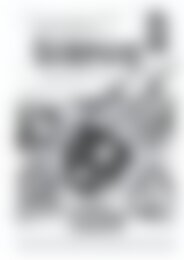RIC-20225 Primary Grammar and Word Study Foundation – Figures of Speech
You also want an ePaper? Increase the reach of your titles
YUMPU automatically turns print PDFs into web optimized ePapers that Google loves.
©R.I.C. Publications<br />
Low Resolution Images<br />
Display Copy
<strong>Primary</strong> grammar <strong>and</strong> word study (Book A)<br />
Published by R.I.C. Publications ® 2008<br />
Copyright © by R.I.C. Publications ® 2008<br />
This master may only be reproduced by the<br />
original purchaser for use with their class(es). The<br />
publisher prohibits the loaning or onselling <strong>of</strong> this<br />
master for the purposes <strong>of</strong> reproduction.<br />
<strong>RIC</strong><strong>–</strong><strong>20225</strong><br />
Copyright Notice<br />
Blackline masters or copy masters are published <strong>and</strong><br />
sold with a limited copyright. This copyright allows<br />
publishers to provide teachers <strong>and</strong> schools with a<br />
wide range <strong>of</strong> learning activities without copyright<br />
being breached. This limited copyright allows the<br />
purchaser to make sufficient copies for use within<br />
their own education institution. The copyright is not<br />
transferable, nor can it be onsold. Following these<br />
instructions is not essential but will ensure that you,<br />
as the purchaser, have evidence <strong>of</strong> legal ownership<br />
to the copyright if inspection occurs.<br />
For your added protection in the case <strong>of</strong> copyright<br />
inspection, please complete the form below. Retain<br />
this form, the complete original document <strong>and</strong> the<br />
invoice or receipt as pro<strong>of</strong> <strong>of</strong> purchase.<br />
Name <strong>of</strong> Purchaser:<br />
Date <strong>of</strong> Purchase:<br />
Supplier:<br />
School Order# (if applicable):<br />
Signature <strong>of</strong> Purchaser:<br />
©R.I.C. Publications<br />
Low Resolution Images<br />
Display Copy<br />
Internet websites<br />
In some cases, websites or specific URLs may be recommended. While these are checked <strong>and</strong> rechecked at the time <strong>of</strong> publication,<br />
the publisher has no control over any subsequent changes which may be made to webpages. It is strongly recommended that the class<br />
teacher checks all URLs before allowing students to access them.<br />
View all pages online<br />
PO Box 332 Greenwood Western Australia 6924<br />
Website: www.ricpublications.com.au<br />
Email: mail@ricgroup.com.au
<strong>Primary</strong> grammar <strong>and</strong><br />
word study <strong>–</strong> Book A<br />
Foreword<br />
<strong>Primary</strong> grammar <strong>and</strong> word study is a series <strong>of</strong> seven books designed<br />
to introduce students to parts <strong>of</strong> speech, ways to underst<strong>and</strong> <strong>and</strong> choose<br />
words, punctuation <strong>and</strong> figures <strong>of</strong> speech.<br />
Titles in this series:<br />
• <strong>Primary</strong> grammar <strong>and</strong> word study Book A (Ages 5<strong>–</strong> 6)<br />
• <strong>Primary</strong> grammar <strong>and</strong> word study Book B (Ages 6<strong>–</strong>7)<br />
• <strong>Primary</strong> grammar <strong>and</strong> word study Book C (Ages 7<strong>–</strong>8)<br />
• <strong>Primary</strong> grammar <strong>and</strong> word study Book D (Ages 8<strong>–</strong>9)<br />
• <strong>Primary</strong> grammar <strong>and</strong> word study Book E (Ages 9 <strong>–</strong>10)<br />
• <strong>Primary</strong> grammar <strong>and</strong> word study Book F (Ages 10<strong>–</strong>11)<br />
• <strong>Primary</strong> grammar <strong>and</strong> word study Book G (Ages 11<strong>–</strong>12)<br />
Teachers notes ..............................................iv <strong>–</strong> v<br />
English curriculum links ...................................... v<br />
Literacy character explanation ..................... vi <strong>–</strong> vii<br />
Checklists ................................................... viii <strong>–</strong> xi<br />
Parts <strong>of</strong> speech ............................................. 2<strong>–</strong>33<br />
Nouns ............................................................. 2<strong>–</strong>5<br />
Verbs ............................................................. 6<strong>–</strong>11<br />
Adjectives .................................................... 12<strong>–</strong>17<br />
Adverbs ....................................................... 18<strong>–</strong>21<br />
Pronouns ..................................................... 22<strong>–</strong>25<br />
Conjunctions ............................................... 26<strong>–</strong>27<br />
Determiners ................................................ 28<strong>–</strong>31<br />
Prepositions ................................................ 32<strong>–</strong>33<br />
Contents<br />
<strong>Word</strong>s that change .................................... 50<strong>–</strong>53<br />
Plurals .................................................... 50<strong>–</strong>53<br />
<strong>Word</strong>s <strong>and</strong> their meanings ........................ 54<strong>–</strong>57<br />
Synonyms ............................................... 54<strong>–</strong>55<br />
Antonyms ............................................... 56<strong>–</strong>57<br />
Confused words ........................................ 58<strong>–</strong>61<br />
Punctuation ................................................. 62<strong>–</strong>75<br />
©R.I.C. Publications<br />
Low Resolution Images<br />
Display Copy<br />
Full stops .................................................... 62<strong>–</strong>63<br />
Question marks ........................................... 64<strong>–</strong>65<br />
Exclamation marks ...................................... 66<strong>–</strong>67<br />
Capital letters .............................................. 68<strong>–</strong>71<br />
Commas ...................................................... 72<strong>–</strong>73<br />
Apostrophes ................................................ 74<strong>–</strong>75<br />
Underst<strong>and</strong>ing <strong>and</strong> choosing words .......... 34<strong>–</strong>61<br />
<strong>Word</strong>s that are similar .............................. 34<strong>–</strong>49<br />
Homographs ........................................... 34<strong>–</strong>35<br />
Homophones .......................................... 36<strong>–</strong>37<br />
<strong>Word</strong> groups ........................................... 38<strong>–</strong>49<br />
<strong>Figures</strong> <strong>of</strong> speech ........................................ 76<strong>–</strong>83<br />
Alliteration .................................................... 76<strong>–</strong>77<br />
Similes ......................................................... 78<strong>–</strong>79<br />
Onomatopoeia .............................................. 80<strong>–</strong>81<br />
Personification .............................................. 82<strong>–</strong>83<br />
R.I.C. Publications ® www.ricpublications.com.au iii<br />
<strong>Primary</strong> grammar <strong>and</strong> word study
<strong>Figures</strong> <strong>of</strong> speech checklist<br />
Name <strong>of</strong> student Alliteration Similes Onomatopoeia Personification<br />
©R.I.C. Publications<br />
Low Resolution Images<br />
Display Copy<br />
R.I.C. Publications ® www.ricpublications.com.au xi<br />
<strong>Primary</strong> grammar <strong>and</strong> word study
<strong>Figures</strong> <strong>of</strong> speech<br />
Alliteration<br />
Focus<br />
Alliteration<br />
Definition<br />
• Alliteration is the repetition <strong>of</strong> a sound at the<br />
beginning <strong>of</strong> words.<br />
Example:<br />
The wind <strong>and</strong> the waves whipped the walrus<br />
around.<br />
Explanation<br />
• Alliteration occurs when the same sound or sound<br />
group is repeated at the commencement <strong>of</strong> two or<br />
more stressed syllables <strong>of</strong> a word group (usually the<br />
first sound in a word).<br />
• Activities using alliteration are <strong>of</strong>ten used when<br />
introducing initial sounds to young students.<br />
• Alliteration is <strong>of</strong>ten used in nursery rhymes <strong>and</strong><br />
poetry.<br />
Example:<br />
Baa baa black sheep ...<br />
• Alliteration can make rhymes, poems or songs<br />
easier to remember.<br />
• Alliteration is a useful writing tool to create special<br />
effects.<br />
Example:<br />
splish, splosh, splash<br />
Worksheet information<br />
• Read the words in Question 1 with the students <strong>and</strong><br />
allow them time to look at the pictures.<br />
• Read <strong>and</strong> discuss the explanation, give some<br />
examples <strong>and</strong> ask the students for some examples.<br />
• Read the text in Question 2 <strong>and</strong> allow the students to<br />
draw colourful pictures.<br />
Ideas for further practice<br />
• Make up <strong>and</strong> say nonsense, alliterative stories using<br />
different common nouns that have the same sound.<br />
Draw pictures to illustrate them.<br />
• Learn to say tongue twisters such as ‘Peter Piper<br />
picked a peck <strong>of</strong> pickled peppers’.<br />
• Read initial sounds charts which utilise alliteration<br />
for phonics characters or sentences.<br />
Example:<br />
Lucy Lamplighter<br />
Answers<br />
Teacher check<br />
©R.I.C. Publications<br />
Low Resolution Images<br />
Display Copy<br />
<strong>Primary</strong> grammar <strong>and</strong> word study 76<br />
www.ricpublications.com.au R.I.C. Publications ®
Alliteration<br />
1. Read the words <strong>and</strong> look at the pictures.<br />
hot house<br />
two turtles<br />
When the same sound is repeated at the<br />
beginning <strong>of</strong> words it is called alliteration.<br />
2. Draw pictures to match.<br />
©R.I.C. Publications<br />
Low Resolution Images<br />
Display Copy<br />
crazy cat<br />
dirty dog<br />
3. Write a sentence with alliteration.<br />
R.I.C. Publications ® www.ricpublications.com.au 77<br />
<strong>Primary</strong> grammar <strong>and</strong> word study
<strong>Figures</strong> <strong>of</strong> speech<br />
Similes<br />
Focus<br />
Similes<br />
Definition<br />
• A simile compares one thing with another. Similes<br />
are usually introduced by the words ‘as’ or ‘like’.<br />
Example:<br />
He was as cunning as a fox.<br />
She slept like a log.<br />
Explanation<br />
• Similes are figures <strong>of</strong> speech. They are examples <strong>of</strong><br />
figurative language, as opposed to literal language.<br />
In figurative language, words are used to create<br />
mental images <strong>and</strong> impressions by comparing ideas.<br />
These comparisons help the reader to more clearly<br />
imagine the person, place or thing being described.<br />
• Writers use similes to emphasise a certain<br />
characteristic. They make writing more interesting,<br />
entertaining <strong>and</strong> colourful, as they <strong>of</strong>ten make a link<br />
between two unlike subjects.<br />
Example:<br />
The children ran around the playground like a pack<br />
<strong>of</strong> wild animals.<br />
Worksheet information<br />
• Read the explanation <strong>of</strong> a simile. Ask the students if<br />
they can think <strong>of</strong> any other examples.<br />
• <strong>Study</strong> each picture with the class <strong>and</strong> ask the<br />
students to think <strong>of</strong> the missing words.<br />
• Students draw illustrations <strong>of</strong> the simile in<br />
Question 2. Discuss which word introduces this<br />
simile—‘as’.<br />
Ideas for further practice<br />
• Choose a simile from the worksheet <strong>and</strong> use it in a<br />
sentence.<br />
• Look in familiar texts to identify similes.<br />
• Draw or paint pictures to make a class simile book<br />
for the reading corner.<br />
Answers<br />
1. (a) bee (b) snail<br />
(c) light<br />
(d) cold<br />
(e) blind, bat<br />
(f) wise, owl<br />
2. Teacher check<br />
©R.I.C. Publications<br />
Low Resolution Images<br />
Display Copy<br />
<strong>Primary</strong> grammar <strong>and</strong> word study 78<br />
www.ricpublications.com.au R.I.C. Publications ®
Similes<br />
A simile says one thing is like another;<br />
for example: She is as quiet as a mouse.<br />
1. Use the words below to finish the similes.<br />
light bat wise snail owl bee blind cold<br />
(a) as busy as a<br />
(c) as<br />
a feather<br />
(e) as<br />
as<br />
as a<br />
(b) as slow as a<br />
(d) as<br />
ice<br />
©R.I.C. Publications<br />
Low Resolution Images<br />
Display Copy<br />
as<br />
(f) as<br />
as an<br />
2. Draw <strong>and</strong> colour a<br />
picture <strong>of</strong> this simile.<br />
as playful as a kitten<br />
R.I.C. Publications ® www.ricpublications.com.au 79<br />
<strong>Primary</strong> grammar <strong>and</strong> word study
<strong>Figures</strong> <strong>of</strong> speech<br />
Onomatopoeia<br />
Focus<br />
Onomatopoeia<br />
Definition<br />
• Onomatopoeia is a word which imitates the sound<br />
<strong>of</strong> what it describes.<br />
Example:<br />
plop or zoom<br />
Explanation<br />
• <strong>Figures</strong> <strong>of</strong> speech are used to make language more<br />
interesting, memorable or surprising. There are<br />
three distinct groups: phonological figures <strong>of</strong> speech<br />
(based on sound effects); lexical figures <strong>of</strong> speech<br />
(depending for their effect on the use <strong>of</strong> words);<br />
<strong>and</strong> syntactic figures <strong>of</strong> speech (depending for their<br />
effect on sentence structure).<br />
• Phonological figures <strong>of</strong> speech include: alliteration—<br />
the use <strong>of</strong> the same sound at the beginning <strong>of</strong> words<br />
(for example: The slimy snake silently slithered);<br />
assonance—the use <strong>of</strong> internal rhyme by using<br />
the same vowel or consonant sounds within words<br />
which follow each other or are close together (for<br />
example: double trouble); <strong>and</strong> onomatopoeia—the<br />
use <strong>of</strong> a word that imitates what it describes (for<br />
example: the babbling <strong>of</strong> a stream).<br />
Worksheet information<br />
• Read stories such as Where does Thursday go? by<br />
Janeen Brian, Night noises by Mem Fox or any other<br />
texts which use onomatopoeia. Identify <strong>and</strong> discuss<br />
the use <strong>of</strong> words such as ‘knick, knack, knock’ <strong>and</strong><br />
‘oogle, gurgle’. Ask the students why they think the<br />
author has used these types <strong>of</strong> words in the story.<br />
• Introduce the students to the term ‘onomatopoeia’<br />
<strong>and</strong> explain that it means a word whose sound<br />
imitates its meaning. Use the books you have read<br />
to provide students with examples <strong>of</strong> these types <strong>of</strong><br />
words.<br />
• Ask students to brainstorm to think <strong>of</strong> any other<br />
words they think belong in this group <strong>of</strong> words.<br />
• The worksheet identifies some words which are<br />
used to represent the sounds <strong>of</strong> animals. This is a<br />
basic introduction to onomatopoeia, using familiar<br />
<strong>and</strong> common words <strong>and</strong> sounds.<br />
Ideas for further practice<br />
• Students can use the word lists developed during<br />
the brainstorm to write a simple poem which uses<br />
onomatopoeia. Add appropriate artwork <strong>and</strong> display.<br />
• Create labels for display around the classroom, using<br />
onomatopoeia for everyday objects; for example,<br />
The cupboard door opens with a screech.<br />
Answers<br />
click-clack, purr, buzz, hiss, wo<strong>of</strong>, moo<br />
©R.I.C. Publications<br />
Low Resolution Images<br />
Display Copy<br />
<strong>Primary</strong> grammar <strong>and</strong> word study 80<br />
www.ricpublications.com.au R.I.C. Publications ®
1. Read the words.<br />
2. Look at the animals.<br />
3. Write the correct word<br />
in each speech bubble.<br />
Animal sounds<br />
Onomatopoeia is<br />
when a word sounds<br />
like what it is describing.<br />
hiss wo<strong>of</strong> click-clack purr buzz moo<br />
©R.I.C. Publications<br />
Low Resolution Images<br />
Display Copy<br />
R.I.C. Publications ® www.ricpublications.com.au 81<br />
<strong>Primary</strong> grammar <strong>and</strong> word study
<strong>Figures</strong> <strong>of</strong> speech<br />
Personification<br />
Focus<br />
• Personifying animals <strong>and</strong> objects<br />
Definition<br />
• Personification is a way <strong>of</strong> describing non-human<br />
things (such as animals <strong>and</strong> inanimate objects)<br />
using human traits <strong>and</strong> abilities, such as speaking.<br />
Example:<br />
The wind whistled through the cowering trees.<br />
Explanation<br />
• Personifying an object can help readers underst<strong>and</strong>,<br />
sympathise with, connect or react emotionally to<br />
non-human characters. Personification can inspire<br />
imagery <strong>and</strong> emotion, <strong>and</strong> provide a different<br />
perspective for an everyday object.<br />
• Personification is <strong>of</strong>ten used in poetry, fables <strong>and</strong><br />
fairytales.<br />
Worksheet information<br />
• For this activity, teachers will need to gather some<br />
magazines, scissors <strong>and</strong> glue for students to use.<br />
• Fables, nursery rhymes <strong>and</strong> fairytales frequently<br />
have animals with human abilities <strong>and</strong> traits as<br />
main characters. Teachers may wish to read<br />
some examples <strong>of</strong> these as an introduction to the<br />
worksheet.<br />
• Teachers might alternatively wish to read some<br />
poetry to the students <strong>and</strong> discuss how objects<br />
or animals were given human traits in the poem.<br />
Examples <strong>of</strong> some age appropriate poems include<br />
‘Two sunflowers move in the yellow room’ by William<br />
Blake; ‘In the garden’, ‘The sky is low’ <strong>and</strong> other<br />
poems by Emily Dickinson; or nursery rhymes like<br />
‘Hey diddle diddle’ by Mother Goose.<br />
• Read the chosen text to the students. Discuss how<br />
the objects or animals were given human traits<br />
(actions or emotions) <strong>and</strong> the effect that this had on<br />
the story or poem <strong>and</strong> the students’ responses to the<br />
personification.<br />
• Read the worksheet with the students. Explain the<br />
task <strong>and</strong> allow them to choose a picture from a<br />
magazine to cut out. They glue it onto the page, then<br />
write something that the animal or object would say<br />
if it could speak. Encourage students to be creative,<br />
to think about what sort <strong>of</strong> personality the item<br />
would have <strong>and</strong> how it would ‘think’ <strong>and</strong> ‘feel’.<br />
Ideas for further practice<br />
• Teachers might like to combine a ‘viewing’ lesson<br />
with the study <strong>of</strong> personification by watching an<br />
animated film <strong>and</strong> discussing the way animals<br />
or objects were personified in the film. Disney’s<br />
animated film Beauty <strong>and</strong> the beast has talking <strong>and</strong><br />
dancing crockery <strong>and</strong> furniture.<br />
• Students could write a short narrative about the<br />
animal or object they chose for the worksheet. They<br />
could write about where it lives, <strong>and</strong> what it likes to<br />
eat <strong>and</strong> do.<br />
Answers<br />
Teacher check<br />
©R.I.C. Publications<br />
Low Resolution Images<br />
Display Copy<br />
<strong>Primary</strong> grammar <strong>and</strong> word study 82<br />
www.ricpublications.com.au R.I.C. Publications ®
Talking bunnies!<br />
Real animals <strong>and</strong> things don’t talk<br />
or act like people, do they?<br />
1. Find a picture <strong>of</strong> an<br />
animal or thing.<br />
2. Cut it out <strong>and</strong> glue<br />
it below.<br />
3. Write what you<br />
think it might say if<br />
it could speak.<br />
Sometimes in stories, plants, tools<br />
<strong>and</strong> animals can talk <strong>and</strong> do things<br />
people do. This makes stories<br />
interesting <strong>and</strong> fun.<br />
©R.I.C. Publications<br />
Low Resolution Images<br />
Display Copy<br />
R.I.C. Publications ® www.ricpublications.com.au 83<br />
<strong>Primary</strong> grammar <strong>and</strong> word study


















